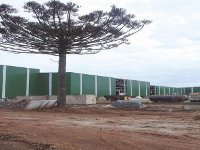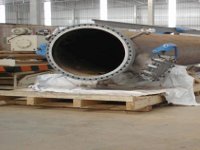The MDF Converts
26 November 2009Even in Brazil the international credit crunch and short term market uncertainty, magnified by the launch of fresh capacity schemes by big MDF players, are now deterring more newcomers from actually launching ambitious investment plans.
While two plywood companies in southern Brazil, Indústria de Compensados Sudati Ltda and Indústria de Compensados Guararapes Ltda, both of Palmas, Paraná state, did each launch a new Chinese-built MDF line of 180,000m3/year early this year, other firms have shelved their new panel plans for the moment.
Even Sudati and Guararapes, who could have picked a better time to invest in an unfamiliar market, are finding the going tough at their respective plants in Otacilio Costa and Caçador, both in Santa Catarina state. Each one is operating a line supplied by Shanghai Wood Based Panel Machinery Co (SWPM).
Although the crisis was undoubtedly biting in Brazil early this year, the new players seemed to have found market niches for some of their output and in mid-year continued to invest in line and product enhancement. They strenuously denied industry rumours they were struggling and ready to halt production in the face of fierce competition from the big players.
Far to the north, at the tropical heart of Brazil’s traditional hardwood plywood producing region in Pará state, another group is proceeding with its own novel MDF project. Floraplac Industrial MDF Ltda, part of Pará’s plywood and forestry group Rio Concrem Industrial, plans to launch that region’s first MDF line using eucalypt and planted paricá, a high density, fast growing local native hardwood.
Floraplac too is employing Chinese technology, with a similar-sized line, also provided by the Dieffenbacher subsidiary SWPM, at its plant now under construction in Paragominas, Pará. In March 2009, the MDF line arrived in Brazil aboard a Philippine ship from China and is expected to be ready to produce panels between March and November 2010.
Floraplac, which owns 30,000 hectares of plantation paricá – South America’s biggest – aims to build up sales in Brazil’s fast-developing north east. It will take advantage of its location, close to this burgeoning marketplace, while competing MDF producers are forced to ship huge distances overland from southern Brazil.
It is this northern MDF pioneer that has caught the attention of some leading Brazilian panel makers, all too ready to dismiss as illusory the plywood makers’ dream of sky-high MDF prices obtained with the aid of advanced, low cost, trouble- free Chinese technology.
“They [would be MDF producers] were attracted by the MDF price and the low price of Chinese equipment. But MDF prices are dropping 20% this year.....they will discover later on that Chinese deals are only good for the Chinese in the long term,declared Flavio Maluf, president of panel maker Eucatex SA. But Floraplac could make a go of it in the fast expanding northeastern market, he concedes.
Although one southern would-be MDF convert, Maseal Indústria de Compensados Ltda, seems to have pulled out of a promising Chinese MDF mill plan in Mato Grosso do Sul state at the last moment, another four Brazilian plywood makers are reported to be preparing to enter the MDF world.
According to industry sources they include Battistella Indústria e Comercio Ltda of Rio Negrinho, Santa Catarina state, along with three Paraná state firms: Guarapuava-based Repinho Reflorestadora de Madeiras e Compensados Ltda; Indústrias J Bettega SA of Bituruna and Miraluz Indústria e Comercio de Madeiras Ltda, based in Sengés.
Plywood companies’ evident enthusiasm for this change of product direction is now tempered by caution over investing at a time when even Brazil’s biggest MDF players are facing a fiercely competitive market and still have spare capacity.
“When you look at projects like this, you consider the market, and don’t really know how long it will take for the payback on your investment. That’s the major question causing many companies to hesitate at the moment,explained Henrique Zanin, a Brazilian industry consultant whose firm, Organon Consultoria e Engenharia advises some plywood producers on the MDF switch and suitable technology.
He recalled how many plywood firms had reached “a cross-roads because their products were in decline, with costs soaring. They had to come up with an alternative [product] or their companies would just die,stressed Mr Zanin, but added that they do come equipped with their own forest resources and experience of the wider wood products business.
Mr Zanin pointed to a gradual change of approach by several would-be converts. Some firms, deterred by the experiences of some pioneer counterparts who bought new Chinese MDF lines, are considering buying European technology. They are looking at acquiring upgraded secondhand German machinery in place of outdated Chinese multi-daylight press lines, he said when WBPI met him in São Paulo this June.
The Brazilian plywood makers are realising not only the complexity of learning to do business with China, but their dependence on a Chinese supplier for the plant’s adaptation for Brazil, its assembly and start-up. Chinese technology is still unfamiliar in a country dominated by European machinery and its more advanced, continuous-press lines.
The would-be MDF producers are discovering the relative benefits of greater efficiency and fibre and resin cost savings – particularly for thinner board – to be gained from a continuous line, against the less advanced batch lines offered by most Chinese manufacturers.
However, with Brazil’s industry dominated by ever-bigger panel groups and huge-volume MDF lines, the domestic market is developing additional niche business, conversely more suited to batch production. Today, with a number of smaller multi-opening press lines closing down across Europe, the Brazilian newcomers can acquire reconditioned older machinery ideal for niche volume business, according to Mr Zanin.
Organon consultants visit European countries to inspect machinery that may have run for as long as 20 years, and advise potential Brazilian buyers on further upgrades. They have also checked out Asian options, including China and Malaysia.
“Despite being secondhand, the European lines are more advanced and upgraded than the new Chinese equipment. What’s important is that Brazil has enough technical engineering skill to assemble and to upgrade such lines.
“But the Chinese [lines] are not discouraged here. They are still an option,said Mr Zanin who believes that MDF makers with successful Chinese-equipped plants will probably continue to use such machinery.
After just seven months of operating, at the height of one of the worst international recessions ever, Guararapes’ MDF division, Guararapes Panéis, has a foothold in the market with its sanded and now melamine faced board. It recently installed a 72,000m3/year Brazilian low pressure laminate line supplied by the Curitiba-based firm Omeco Ltda which, in July, was running full-out, round the clock, reported general manager Mariano Dantur Do Canto.
“The short-cycle press for boards 2.75m long is running well. With this we have a good mix of products selling coated and raw boards,he told WBPI. Guararapes’ sister convert, Sudati, has also been improving the quality of its pine-based MDF panels and its line efficiency. It installed a fibre mat water spray system for the line, which is capable of turning out board from eight to 22mm thickness. Guararapes was considering a similar installation, reported Mr Dantur Do Canto in August.
Some smaller panel makers, like the southern plywood newcomers, are said to be carving out niche markets as low-volume finished panel suppliers to smaller furniture companies in the big furniture manufacturing zones.
New MDF players, cutting their teeth on a new product – and investing during the worst economic crisis for decades – can certainly expect a rough ride in the market. Despite the prospect of a welcome rally in Brazil’s home market in the second half of 2009, these small players will be lucky to survive a battering as the leaders merge to form giant new groups.
But Brazilian plywood families come from tough and resourceful stock. They have proved determined and flexible in the face of change before, having successfully reinvented themselves from lumber to plywood producers. So, some of the newcomers could still survive.


